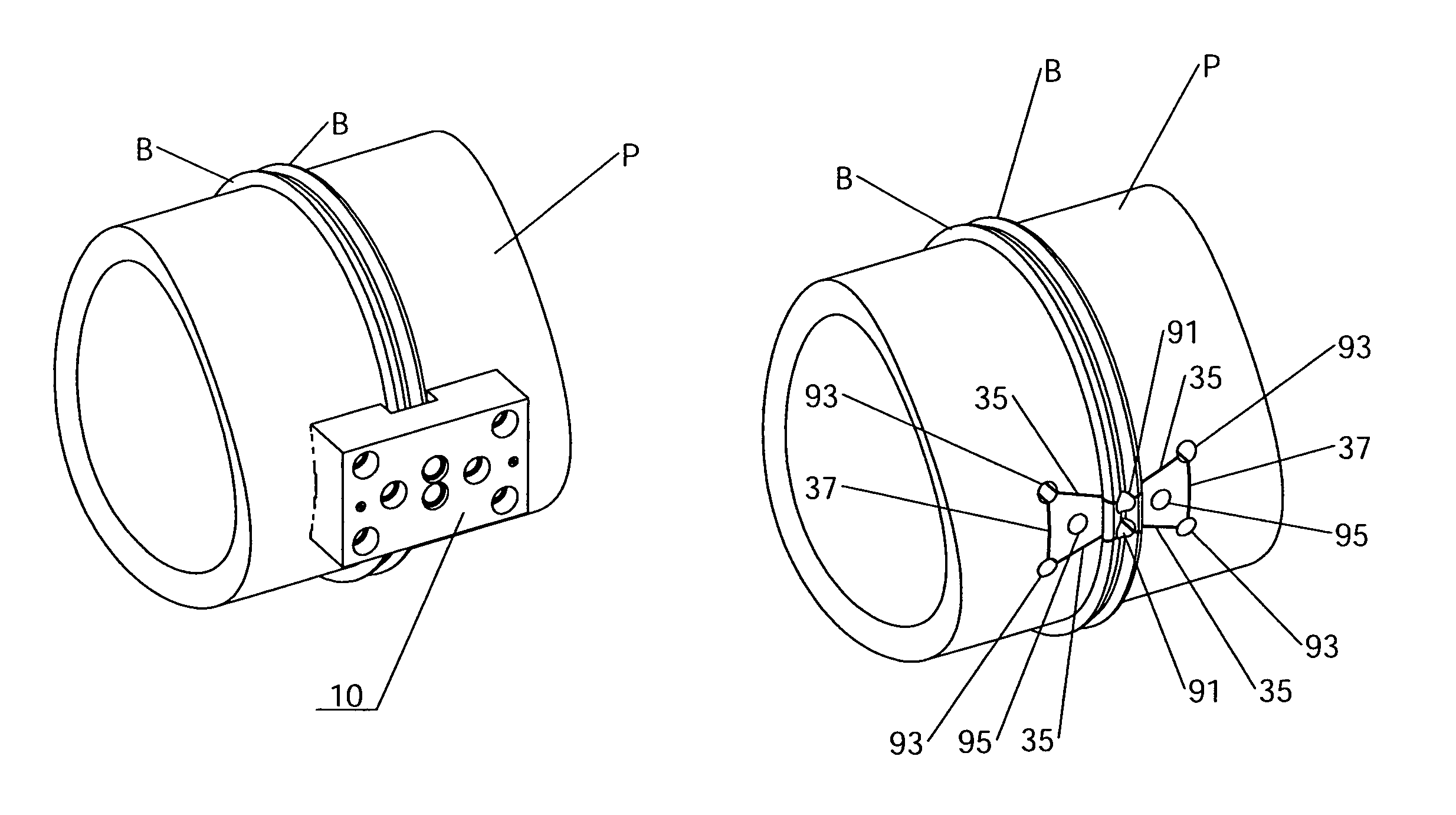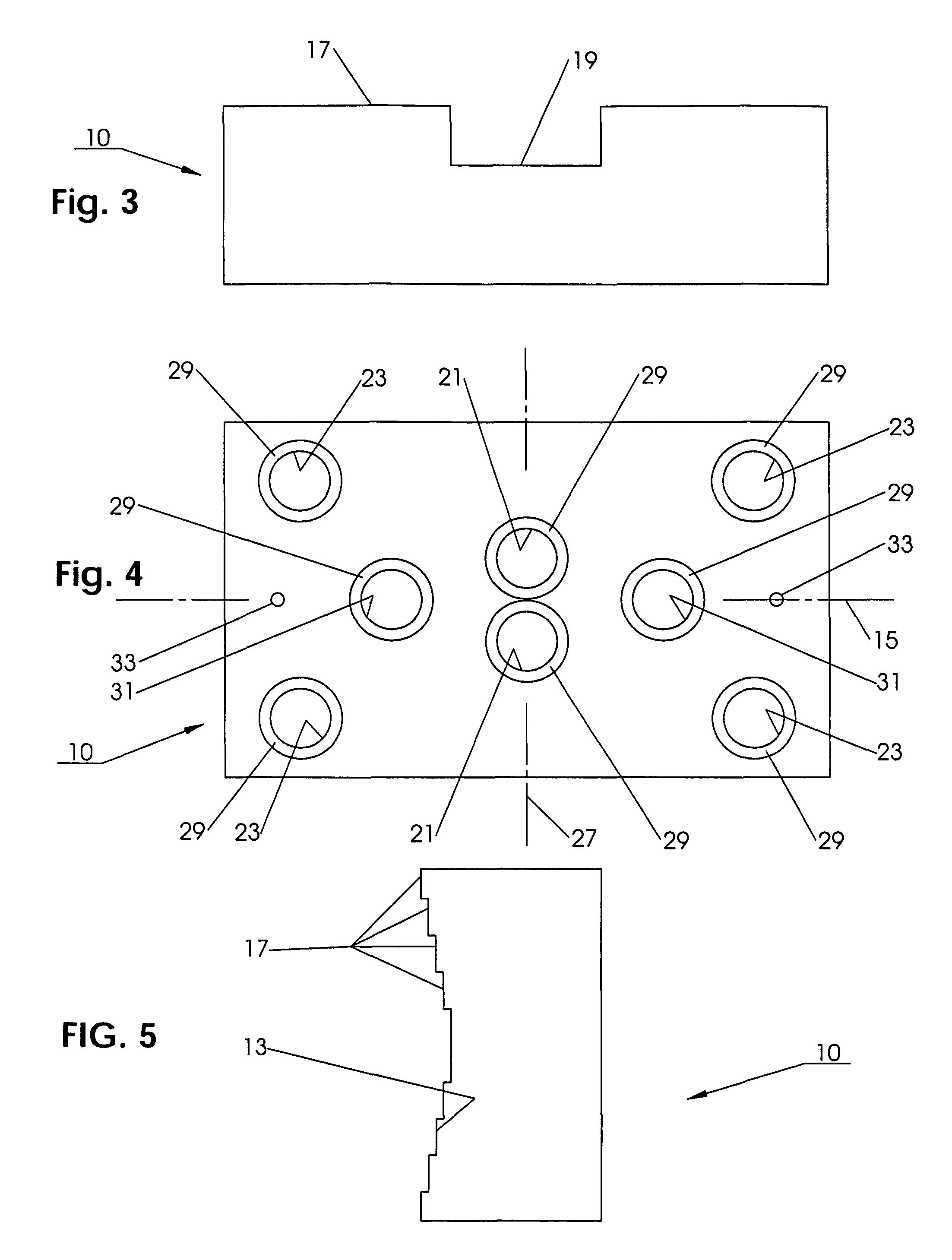Method and template for producing a tensile test coupon
a coupon and tensile technology, applied in the direction of tensile/compressive force of materials, instruments, mechanical means, etc., can solve the problems of high force required to bend the strap, destructive field-testing methods have been devised, and the instrumentation and apparatus are not suited for field use, etc. to achieve the effect of convenient site location
- Summary
- Abstract
- Description
- Claims
- Application Information
AI Technical Summary
Benefits of technology
Problems solved by technology
Method used
Image
Examples
first embodiment
of the Template
[0071]Turning to FIGS. 1-12, a screw-in-place, symmetric mount embodiment of a template 10 for producing a tensile test coupon 80, seen in FIGS. 13-17, from a plastic pipe P or a fused joint J of a plastic pipe P is illustrated. The template 10 is useful over a broad range of pipe diameters and compositions, but is particularly applicable for medium or high density polyethylene pipes.
[0072]The template 10 is formed using a relatively thick plate of material such as commercially available aluminum or steel suited for machining. The template 10 has a base 11 which, in using the template 10, will be abutted against the outer surface of the pipe P. The contour of the base 11 can take many shapes so long as the template 10 is stable in its alignment when held against a pipe P.
[0073]As shown, the base 11 has a V-groove 13 which, in cross-section, is transverse to the longitudinal axis 15 of the template 10. Thus, the pipe and template longitudinal axes L and 15 will be para...
second embodiment
of the Template
[0078]The first embodiment template 10 used screws to fix the template securely to the outer surface of the pipe to be tested. This method works well where pipes are fairly structurally stable, as when pipes are heavy wall and / or of large diameter. This method works adequately to stabilize the template to the degree necessary to produce a precisely drilled coupon. Smaller pipes lack the necessary rigidity and tend to displace out of the way of the drill bit as the holes are being drilled, possibly leading to distorted hole arrays in the coupons so that the drilled holes are not precisely aligned as is desired. The U-bolt arrangement envelopes the pipe being tested and draws it into firm contact with the stabilizing contour of the template. The U-bolts are threaded on their ends and threaded nuts are used to tighten them against the pipe, drawing it into firm contact with the template. These U-bolts also help the pipe to maintain its shape while it is being drilled.
[00...
third embodiment
of the Template
[0097]Looking at FIGS. 29-33, a U-bolt, asymmetric mount embodiment of the template 310 for producing a tensile test coupon 380, best seen in FIGS. 40-45, from a plastic-pipe P or a fused joint J of a plastic pipe P is illustrated. The template 310 is useful over a broad range of pipe diameters and compositions, but is particularly applicable for smaller diameter medium or high density polyethylene pipes.
[0098]A coupon hole-array profile with a single reduced section lying in the plane of the interface of two fused pipes has to be interpreted in order to provide a meaningful estimation as to the quality of the joint. While a tensile coupon prepared from a single stick of good quality base pipe will always fail in the reduced area in a ductile fashion, a tensile coupon prepared at a pipe joint presents multiple possibilities. The very worst joints will break abruptly under tensile load, leaving a smooth parting face, and showing no evidence of cohesion between the pipe...
PUM
| Property | Measurement | Unit |
|---|---|---|
| tensile test | aaaaa | aaaaa |
| tensile force | aaaaa | aaaaa |
| tensile strength | aaaaa | aaaaa |
Abstract
Description
Claims
Application Information
 Login to View More
Login to View More - R&D
- Intellectual Property
- Life Sciences
- Materials
- Tech Scout
- Unparalleled Data Quality
- Higher Quality Content
- 60% Fewer Hallucinations
Browse by: Latest US Patents, China's latest patents, Technical Efficacy Thesaurus, Application Domain, Technology Topic, Popular Technical Reports.
© 2025 PatSnap. All rights reserved.Legal|Privacy policy|Modern Slavery Act Transparency Statement|Sitemap|About US| Contact US: help@patsnap.com



